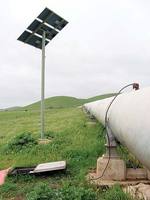Keeping track of Adelaide's chlorine
 Engineering Engineering
Drinking water from a tap is something that most of us take for granted in Australia, confident that it is safe, free of bacteria and harmful viruses. This is primarily due to the addition of a disinfectant to the water - most commonly chlorine. But civil and environmental engineering staff and students from the University of Adelaide (with the support of United Water and the Cooperative Research Centre for Water Quality and Treatment) have gone one step further in ensuring the health of our water system. Professor Graeme Dandy and Associate Professor Holger Maier from the School of Civil & Environmental Engineering have supervised a project to predict chlorine residuals at strategic points in Adelaide's water distribution system. PhD student Rob May has been working on this project since 2003. Using the Myponga pipeline as a field study, a forecasting model has been developed to accurately predict chlorine residuals near the town of Willunga, 24 hours in advance. This is 20 km from the original chlorine dosage point at the Myponga water treatment plant. "As the water travels down a pipeline the chlorine reacts with organic matter in the water and is gradually converted into disinfection by-products. The operators need to ensure that by the time the water reaches the consumers the chlorine residuals are still at an acceptable level," Professor Dandy said. Too little chlorine can allow bacteria to regrow in the system, thus increasing the risk of waterborne disease. But high levels of chlorine also create problems: a chemical taste in the water, increased costs, and disinfection by-products, which may themselves have adverse health effects. "It is important to achieve a balance, and this study has revealed how chlorine levels change in the distribution process and what factors affect this change." Chlorine monitors strategically placed along a 20-kilometre stretch of the Myponga pipeline measure the water temperature and chlorine residuals at a number of locations. This is supplemented by flow data for the pipeline and its offtakes that is collected on a regular basis by United Water and SA Water. This data allows engineers to track changes in the chlorine concentration at given points. The project used Artificial Neural Networks (a mathematical modelling technique) to forecast chlorine residuals 24 hours in advance. "We have achieved some very good results from this. Our aim is to set up a system to advise the operator on what chlorine levels they should be dosing at the plant. "We are certainly at the forefront of research in this area internationally," Professor Dandy said. "No-one else is investigating the use of artificial neural networks to forecast chlorine levels in the water distribution network, with the final goal being an automated advisory control system. This is cutting-edge stuff." Story by Candy Gibson
|





